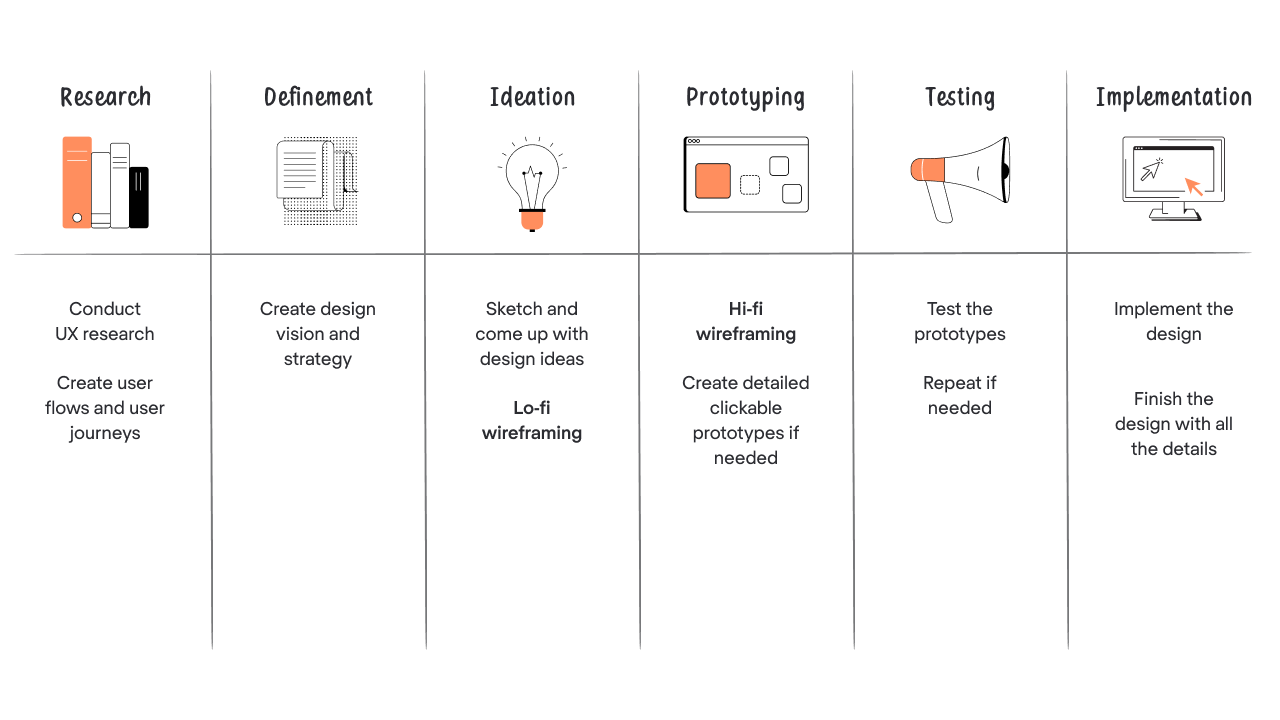The word 'wireframes' may sound complex, boring, or even intimidating for those outside the industry. But if you are in the design or product field, you know that wireframes are actually a great way to present how the digital product will work and look.
We are a design agency for product companies, so we know a great deal about wireframes and their importance in the design process. We also know that what seems obvious to designers can still be a mystery for specialists in other fields. In this article, we will address all of your concerns related to high-fidelity wireframes and share some examples from our talented UX designers.
But first, it is important to understand the basics.
What is a wireframe?
A wireframe is a schematic layout of a future product, whether a website, an app, or a platform. Wireframe is always a simple text-and-line representation. It is a skeleton of the future product design.
Wireframes are low-fidelity prototypes. This causes some confusion: what is considered a wireframe, as wireframes are prototypes, but not the other way around? This topic requires an in-depth explanation, so when you're curious to learn the difference between wireframes, mockups, and prototypes, go read our article dedicated to the topic.

Usually, wireframes look like schematic blocks with elements that visually illustrate how various components of the website will be organized. They are monochrome, often black and white, but not always.

An understanding of how and why we use wireframes in the design process can help us with high-fidelity wireframe definition.
Designing a product is a complex journey, so we must break it down into smaller steps.

Wireframing is part of the ideation and prototyping stages of the product design. Depending on the stage of product development, designers use different fidelity wireframes ranging from low to high. From the design point of view, fidelity is how detailed the wireframe of the future product will be.
What is a low-fidelity wireframe?
A low-fidelity (lo-fi) wireframe may vary from a black-and-white paper sketch to a simple digital one. Focusing on the main elements of the design, it usually has boxes and lines depicting the main idea of the website or app. Interpretation of the design is missing, and not much is offered as user interface interaction.

Lo-fi wireframes can reflect a product's basic architecture and features, showing where the content and visual blocks will be placed. With the help of lo-fi wireframes, the designer can visualize concepts and design possibilities at the beginning of the product development phase.
Low-fidelity wireframes are part of the ideation process. As many of the details are missing at this stage, designers usually present them to the client with some additional comments. Lo-fi wireframes are time-saving for both product owners and the design team. Simplicity, effectiveness, and time-saving characteristics make low-fidelity wireframes a valid part of the product development equation.
We hope that by this point, you have an idea of how wireframes work. However, there is still a bigger question to answer.
What is a high-fidelity wireframe?

Following the logic, a high-fidelity (hi-fi) wireframe is an advanced version of a low-fidelity wireframe. However, it is more than a sketch with more details; it is a series of thought-through screens that illustrate each element and the connections between them. But unlike more developed prototypes, wireframes are always static. The graphics of hi-fi wireframes are usually more distinct than those of lo-fi wireframes but not as detailed as those of hi-fi prototypes.

The key difference between low-fidelity and high-fidelity wireframes is that lo-fi represents design direction and general layout, while hi-fi is well-researched and presents a more precise look and functionality of the future product.
Lo-fi sketches can result in human error and deliver confusing messages. High-fidelity, on the other hand, offers fewer chances for human error. The feedback from hi-fi wireframes is more constructive since the participants get the product design idea more clearly, which also contributes to developing a better and more complete user experience. As a result, hi-fi wireframes leave little to no room for misunderstandings and bring more productive results.
Hi-fi wireframes take more time to develop and provide a better visual representation of the main screens. Good hi-fi wireframes should rely on user research to provide a solid base for the finalized UX/UI design. You may notice that our hi-fi wireframes mentioned in this article often differ in detail. The reason is simple: It depends on the project we are working on and the client's request.

More detailed wireframes require a little more time. Still, as you can see from our high-fidelity wireframe examples, they must remain accurate in presenting the future design to avoid confusion.
Now that we have figured out what high-fidelity wireframes are and why they are good, it's about time we addressed the last question.
When to use hi-fi wireframes?
High-fidelity wireframes are one of the most effective UX deliverables. First, they are a great base for more detailed mockups that imitate how the product will work. Wireframes can be used to represent the screens and how they appear after one another when the product is in use.
Hi-fi wireframes can also be used to create a strong framework for your design. High-fidelity wireframes give designers a ground to make better decisions related to the final product's design.
Here's a hi-fi wireframe and finalized design of our project. You can see that wireframe is a pretty accurate representation of what it will become.

One more indicator that the product needs high-fidelity wireframes is when the designer needs to visualize the specific design ideas to stakeholders. It is sometimes difficult for the client to visualize the outcome of the particular software or app based on very simple lo-fi wireframes, while high-fidelity design delivers most of the details, making it easier for the client to approve or suggest changes.
Hi-fi wireframes can also save you when you are building a startup and are aiming to find investors. To not waste a lot of resources, you can opt to use hi-fi wireframes to present your MVP and get investors to see your ideas.
At Eleken, we use high-fidelity wireframes to get feedback on things like:
- The overall the look-and-feel of the future design;
- How readable text is and what size it should be;
- What images to use for buttons and other graphics;
- How big margins should be between different elements
- Whether your logo fits with the overall design.
- And the overall UI layout enhances the aesthetic and content of the future product.
Our Head of Design recommends building hi-fi wireframes when you are creating a product design from scratch. If you are redesigning the existing product, wireframes can be skipped. And let’s not forget about mockups. We build them for almost every project, and the base for mockups are good old hi-fi wireframes.
Conclusion
High-fidelity wireframes are an indispensable tool in the design process, especially when precision and detailed visualization are key. They bridge the gap between basic conceptualization and the final design, providing a clear, detailed preview of the product. Hi-fi wireframes are particularly valuable in stages where stakeholder feedback is crucial, or when presenting a sophisticated design vision that requires more than just basic sketches.
At Eleken, we understand the importance of accurately conveying the design intent to our clients and stakeholders. That's why we leverage high-fidelity wireframes to ensure our designs are not only aesthetically pleasing but also functional and user-friendly. Whether you're starting from scratch or refining an existing product, integrating hi-fi wireframes into your design process can significantly enhance the outcome, leading to a product that not only meets but exceeds expectations.
Book a trial with our designers and see for yourself that wireframes are a great start to future powerful user experiences.







.png)





.png)
